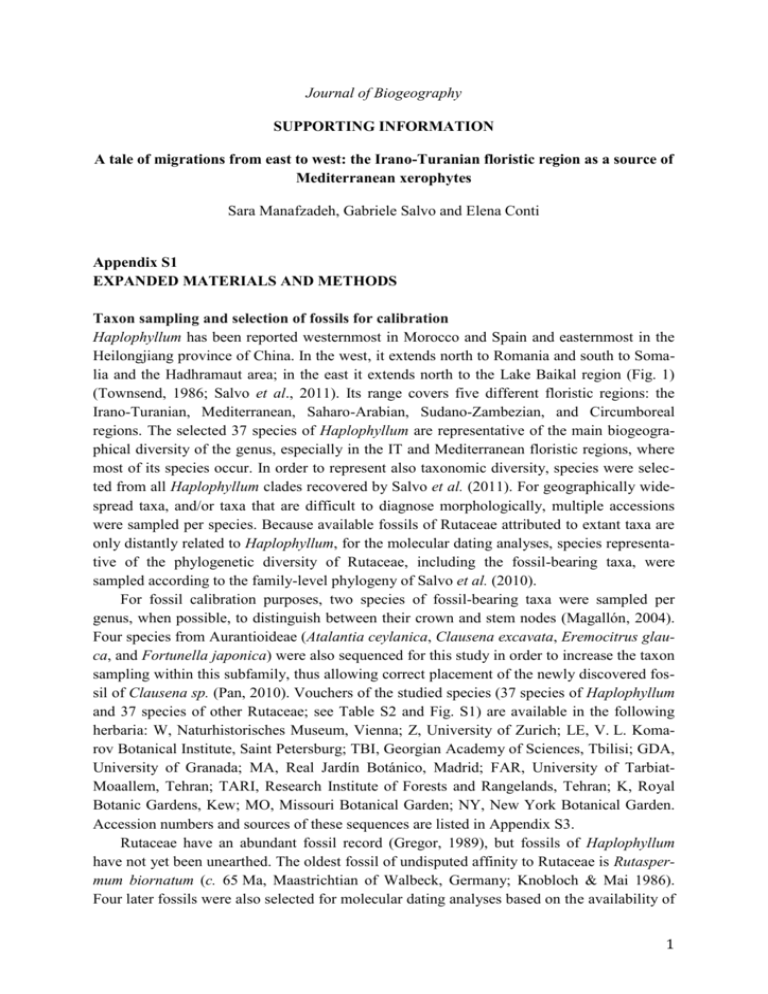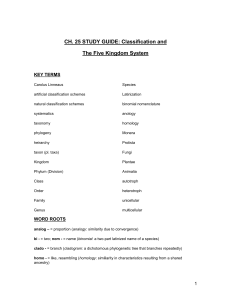jbi12185-sup-0001-AppendixS1
advertisement

Journal of Biogeography SUPPORTING INFORMATION A tale of migrations from east to west: the Irano-Turanian floristic region as a source of Mediterranean xerophytes Sara Manafzadeh, Gabriele Salvo and Elena Conti Appendix S1 EXPANDED MATERIALS AND METHODS Taxon sampling and selection of fossils for calibration Haplophyllum has been reported westernmost in Morocco and Spain and easternmost in the Heilongjiang province of China. In the west, it extends north to Romania and south to Somalia and the Hadhramaut area; in the east it extends north to the Lake Baikal region (Fig. 1) (Townsend, 1986; Salvo et al., 2011). Its range covers five different floristic regions: the Irano-Turanian, Mediterranean, Saharo-Arabian, Sudano-Zambezian, and Circumboreal regions. The selected 37 species of Haplophyllum are representative of the main biogeographical diversity of the genus, especially in the IT and Mediterranean floristic regions, where most of its species occur. In order to represent also taxonomic diversity, species were selected from all Haplophyllum clades recovered by Salvo et al. (2011). For geographically widespread taxa, and/or taxa that are difficult to diagnose morphologically, multiple accessions were sampled per species. Because available fossils of Rutaceae attributed to extant taxa are only distantly related to Haplophyllum, for the molecular dating analyses, species representative of the phylogenetic diversity of Rutaceae, including the fossil-bearing taxa, were sampled according to the family-level phylogeny of Salvo et al. (2010). For fossil calibration purposes, two species of fossil-bearing taxa were sampled per genus, when possible, to distinguish between their crown and stem nodes (Magallón, 2004). Four species from Aurantioideae (Atalantia ceylanica, Clausena excavata, Eremocitrus glauca, and Fortunella japonica) were also sequenced for this study in order to increase the taxon sampling within this subfamily, thus allowing correct placement of the newly discovered fossil of Clausena sp. (Pan, 2010). Vouchers of the studied species (37 species of Haplophyllum and 37 species of other Rutaceae; see Table S2 and Fig. S1) are available in the following herbaria: W, Naturhistorisches Museum, Vienna; Z, University of Zurich; LE, V. L. Komarov Botanical Institute, Saint Petersburg; TBI, Georgian Academy of Sciences, Tbilisi; GDA, University of Granada; MA, Real Jardín Botánico, Madrid; FAR, University of TarbiatMoaallem, Tehran; TARI, Research Institute of Forests and Rangelands, Tehran; K, Royal Botanic Gardens, Kew; MO, Missouri Botanical Garden; NY, New York Botanical Garden. Accession numbers and sources of these sequences are listed in Appendix S3. Rutaceae have an abundant fossil record (Gregor, 1989), but fossils of Haplophyllum have not yet been unearthed. The oldest fossil of undisputed affinity to Rutaceae is Rutaspermum biornatum (c. 65 Ma, Maastrichtian of Walbeck, Germany; Knobloch & Mai 1986). Four later fossils were also selected for molecular dating analyses based on the availability of 1 detailed morphological descriptions, accurate dating associated with the geologic interval of their collection locality, and well-supported affinities with modern taxa: Clausena sp. Burm.f. (Pan, 2010), Toddalia excavata (Chandler) Gregor (Gregor, 1979), Ptelea enervosa H.V. Smith (Smith, 1938), and Skimmia tortonica Palamarev & Usunova (Palamarev & Usunova, 1970). The age estimates are calibrated through the specification of prior age distributions for nodes in the tree constrained by the selected fossils. The most ancient fossilized representative of a clade determines the minimum age of that clade. The parametric distributions can therefore be modelled around the fossil calibration points in the following way: the probability of a clade being younger than its oldest fossil falls immediately to zero, and the probability of it being older than its oldest fossil decays more gradually (Ho & Phillips, 2009). As in a previous study on Ruta (Salvo et al., 2010), we decided to conduct the final BEAST analysis by implementing a root prior informed by available estimates of the age of the root from the oldest reliable fossil of Rutaceae (Knobloch & Mai, 1986). The prior age of the root was then defined by a lognormal distribution with the parameters listed in Table S1. The mean of this distribution corresponds to the oldest, most reliable Rutaceae fossil and the 1% lower tail to the appearance of tricolpate pollen in the fossil record (around 125 Ma; Sanderson & Doyle, 2001; Anderson et al., 2005). Phylogenetic analyses The data set used for phylogenetic inference and molecular dating analyses was aligned in MACCLADE 4.06 (Maddison & Maddison, 2000). Regions of ambiguous alignment were excluded from the analysis. Gap positions were treated as missing data, unequivocally aligned gaps were coded as presence/absence of characters with the software GAPCODER (Young & Healy, 2003) and then added as binary characters to the data matrix. The final, concatenated data matrix comprised 3710 aligned characters (1599 from matK, 1257 from rpl16, 639 from the trnL–trnF region, and 212 from gap coding). The Akaike information criterion (AIC), implemented in MODELTEST 3.06 (Posada & Crandall, 1998), was used to choose the optimal model of sequence evolution for each DNA marker. Bayesian analyses were implemented in MRBAYES 3.2 (Ronquist et al., 2012) using the GTR+G model for rpl16, and the TVM+G model for matK and trnL–trnF. Gap codings were analysed as a separate partition under the Binary Model. Two simultaneous analyses were performed with four Monte Carlo Markov chains (MCMCs, one cold and three incrementally heated), run for 107 generations, sampling every 1000th generation. Each chain used a random tree as a starting point and the default temperature parameter value of 0.2. TRACER 1.5 (Rambaut & Drummond, 2007) was used to check for the convergence of the model likelihood and parameters between the two runs. The first 10% of the calculated generations were discarded as burn-in. A 50% majorityrule consensus tree was calculated in MRBAYES 3.2. For subsequent biogeographical analyses (ancestral area reconstruction), the initial data set of 114 accessions (Fig. S1) was reduced to 77 accessions, representing exclusively the 37 species of Haplophyllum. A phylogeny was inferred from this matrix by using Bayesian inference with the same settings as above. 2 EXPANDED RESULTS Topology of the tree The topology of the BEAST tree was generally well supported, especially the nodes of interest for the biogeographical history of Haplophyllum (nodes A–F, Fig. 3b) and the calibration nodes (nodes 1–4, Fig. 3a), with the exception of node 3. As in Salvo et al. (2011), Haplophyllum is a strongly supported monophyletic genus sister to a clade consisting of the sampled Aurantioideae and the monotypic Cneoridium (Fig. 3a,b: node A). The eastern Mediterranean species and their circumboreal-eastern Mediterranean sister H. suaveolens formed a clade that shared the same common ancestor (Fig. 3b, node E) with the western Mediterranean clade (Fig. 3b, node F). This Mediterranean clade was sister to the IranoTuranian H. telephioides, which occurs in the Anatolian plateau (Fig. 3b, node D). In turn, the superclade was sister to a geographically diverse clade with representatives occurring in all five floristic regions of Haplophyllum (Fig. 3b, node C). Table S1 Information on the four fossils of Rutaceae used as calibration points for the molecular dating analyses. Fossil Material Locality Age Affinity with extant taxa Placement of fossil in phylogeny References Clausena sp. Burm.f. Leaves Sublocality CH41 of the Guang river flora, Ethiopia Late Oligocene (27.23 ± 0.1 Ma) Clausena anisata Stem node of Clausena (node 1 in Fig. 3a) Pan (2010) Toddalia excavata (Chandler) Gregor. Seed Cliff End, Mudeford, England, UK Late Eocene (Bartonian; 40.4–37.2 Ma) Toddalia Stem node of Toddalia (node 2 in Fig. 3a) Gregor (1979) Ptelea enervosa H.V. Smith. Samaras Ballantyne Ranch, Succor Creek valley, Idaho–Oregon boundary, USA Middle Miocene (15.97–11.608 Ma) Ptelea Stem node of Ptelea (node 3 in Fig. 3a) Smith (1938); Call & Dilcher (1995) Skimmia tortonica Palamarev & Usunova. Leaves Milčina lâka, Bezirk Vidin, Bulgaria Late Miocene (Tortonian; 11.608– 7.246 Ma) Skimmia Crown node of Skimmia (node 4 in Fig. 3a) Palamarev & Usunova (1970) 3 Table S2 Distribution of Haplophyllum for the selected areas (Takhtajan, 1986; Townsend, 1986). Areas are shown in Fig. 1. A, Western Asiatic portion of the Irano-Turanian floristic region (WA); B, Central Asian portion of the Irano-Turanian (CA); C, East of the Mediterranean floristic region (EM); D, West of the Mediterranean floristic region (WM); E, SaharoArabian floristic region (SA); F, Sudano-Zambezian floristic region (SZ); G, Circumboreal floristic region (CB). Species name Distribution H. acutifolium H. affine H. albanicum H. bastentanum H. blanchei H. boissierianum H. bucharicum H. buxbaumii H. canaliculatum H. cappadocicum H. coronatum H. dasygynum H. dauricum H. dshungaricum H. dubium H. erythraeum H. furfuraceum H. glaberrimum H. griffithianum H. laristanicum H. latifolium H. linifolium H. lissonotum H. obtusifolium H. patavinum H. pilosum H. popovii H. rechingeri H. robustum H. stapfianum H. suaveolens H. telephioides H. tenue H. tuberculatum H. villosum H. virgatum H. viridulum AB AF C D E C B ACD A A C A AG B AB AF A A AB F B D A AB C AB AB A AB A CG A A ABCDEF A AF A 4 Figure S1 The 50% majority-rule consensus tree of the Bayesian phylogenetic analysis from 114-taxa data set (including 77 from Haplophyllum and 37 from the other subfamilies of Rutaceae). Posterior probability values are indicated above the branches. 5 REFERENCES Anderson, C.L., Bremer, K. & Friis, E.M. (2005) Dating phylogenetically basal eudicots using rbcL sequences and multiple fossil reference points. American Journal of Botany, 92, 1737–1748. Gregor, H.J. (1979) Systematics, biostratigraphy and paleoecology of the genus Toddalia Jussieu (Rutaceae) in the European Tertiary. Review of Palaeobotany and Palynology, 28, 311–363. Gregor, H.J. (1989) Aspects of the fossil record and phylogeny of the family Rutaceae (Zanthoxyleae, Toddalioideae). Plant Systematics and Evolution, 162, 251–265. Ho, S.Y.W. & Phillips, M.J. (2009) Accounting for calibration uncertainty in phylogenetic estimation of evolutionary divergence times. Systematic Biology, 58, 367–380. Knobloch, E. & Mai, D.H. (1986) Monographie der Früchte und Samen in der Kreide von Mitteleuropa. Rozpravy ústredního ústavu geologickénho Praha, 47, 1–219. Maddison, P.G. & Maddison, D.R. (2000) MacClade4: analysis of phylogeny and character evolution. Sinauer, Sunderland, MA. Magallón, S.A. (2004) Dating lineages: molecular and paleontological approaches to the temporal framework of clades. International Journal of Plant Sciences, 165, S7–S21. Palamarev, D. & Usunova, K. (1970) Morphologisch-anatomischer Nachweis der Gattung Skimmia in der Tertiärflora Bulgariens. Comptes Rendus de l’Académie Bulgare des Sciences, 23, 835–838. Pan, A.D. (2010) Rutaceae leaf fossils from the Late Oligocene (27.23 Ma) Guang river flora of northwestern Ethiopia. Review of Palaeobotany and Palynology, 159, 188–194. Posada, D. & Crandall, K.A. (1998) MODELTEST: testing the model of DNA substitution. Bioinformatics, 14, 817–818. Rambaut, A. & Drummond, A.J. (2007) Tracer v1.4. Available at: http://beast.bio.ed.ac.uk/tracer. Ronquist, F., Teslenko, M., van der Mark, P., Ayres, D.L., Darling, A., Höhna, S., Larget, B., Liu, L., Suchard, M.A. & Huelsenbeck, J.P. (2012) MrBayes 3.2: efficient Bayesian phylogenetic inference and model choice across a large model space. Systematic Biology, 61, 539–542. Salvo, G., Ho, S.Y.W., Rosenbaum, G., Ree, R. & Conti, E. (2010) Tracing the temporal and spatial origins of island endemics in the Mediterranean region: a case study from the citrus family (Ruta L., Rutaceae). Systematic Biology, 59, 705–722. Salvo, G., Manafzadeh, S., Ghahremaninejad, F., Tojibaev, K., Zeltner, L. & Conti, E. (2011) Phylogeny, morphology, and biogeography of Haplophyllum (Rutaceae), a species-rich genus of the Irano-Turanian floristic region. Taxon, 60, 513–527. Sanderson, M.J. & Doyle, J.A. (2001) Sources of error and confidence intervals in estimating the age of angiosperms from rbcL and 18S rDNA data. American Journal of Botany, 88, 1499–1516. Smith, H.V. (1938) Some new and interesting late Tertiary plants from Sucker Creek, Idaho–Oregon boundary. Bulletin of the Torrey Botanical Club, 65, 557–564. Takhtajan, A. (1986) Floristic regions of the world. University of California Press, Berkeley, CA. Townsend, C.C. (1986) Taxonomic revision of the genus Haplophyllum (Rutaceae). Hooker’s icones plantarum, vol. Xl, parts I, II, and III. Bentham-Moxon Trustees, Kent, UK. Young, N.D. & Healy, J. (2003) GapCoder automates the use of indel characters in phylogenetic analysis. BMC Bioinformatics, 4, 6. 6






